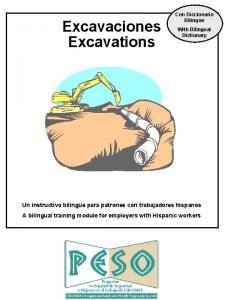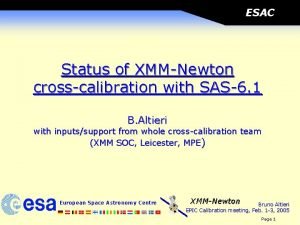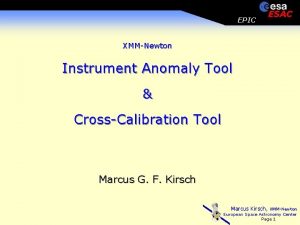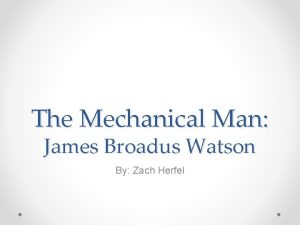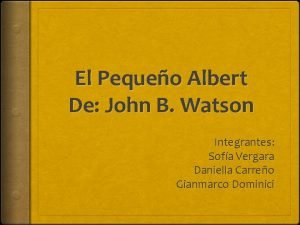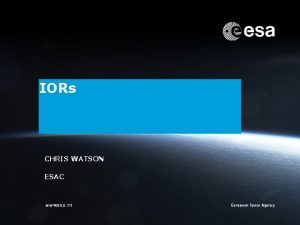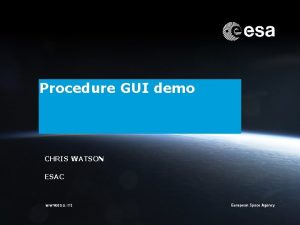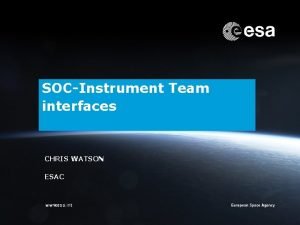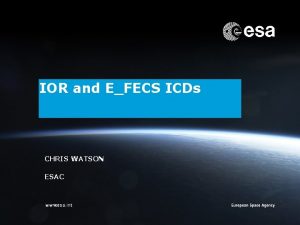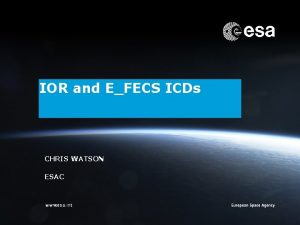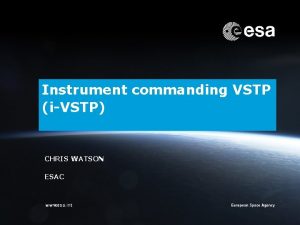Glossary of terms CHRIS WATSON ESAC Chris Watson









- Slides: 9

Glossary of terms CHRIS WATSON ESAC | Chris Watson | ESA/ESAC | Page 1

Intent n Commanding / Mission-planning contains many acronyms and terms that may not be familiar • This is a quick recap of the main terms • Is not necessarily complete • Does not replace the relevant ICDs – it is just a quick reminder ESAC | Chris Watson | ESA/ESAC | Page 2

Planning cycles n n Mission-level planning • Joined-up plan of the whole mission linking science goals to specific parts of the trajectory as part of the SAP • Answers strategic questions like how “shall each perihelion be used? ” • Should fix RSW positions LTP “Long Term Planning” • Elaboration of the SAP plan into greater detail across a ~six month interval • Certain decisions are fixed as an output of this MTP “Medium Term Planning” • Covers same ~six-months as LTP • First-level at which planning uses real commanding products • Required to conform to the decisions taken at LTP • Doesn’t get sent to the spacecraft STP “Short Term Planning” • Covers one week • Does get sent to the spacecraft • Still required to conform to the decisions taken at LTP • Expected to follow the MTP, except for short-term reactive-changes ESAC | Chris Watson | ESA/ESAC | Page 3

Planning cycles n i-VSTP “instrument Very Short Term Planning” • “Last-minute” insertion of additional sequence calls • Intended to cover items like fast-turnaround calibrations that have to go via ground • Very restricted usage – see IOR ICD for details ESAC | Chris Watson | ESA/ESAC | Page 4

Sequences etc. n n n “Sequence” • Essentially a fixed list of telecommands, identifying the sequence-internal delays between each commands (and between sequence time and the very first TC) • Linked to an instrument procedure • Important guidelines on what is a well-defined sequence in SOL-ESC-TN 10034, “Instrument Operations Definition Guidelines” “Sequence call” • A particular instantiation of a sequence • The only means by which the IOR can put commands into the MTL • Defines the time at which the sequence starts execution “Formal parameters” of a sequence • Those few command data fields not set within the command-definition nor within the sequence-definition. • I. e. The “tuneable knobs” exposed by a given sequence • The formal parameter values must then be provided in each sequence call • Some sequences might have zero formal parameters. Very few sequences should have many (>~8) formal parameters ESAC | Chris Watson | ESA/ESAC | Page 5

Sequences etc. n MIB “Mission Information Base” • Database that contains the TM and TC definitions • Sequences are built on top of the TC definitions ESAC | Chris Watson | ESA/ESAC | Page 6

Routine planning n IOR “Instrument Operations Request” • How the instrument teams provide their routine commanding inputs to SOC in Cruise, NMP, EMP n POR “Payload Operations Request” • What the IOR becomes once it has been “turned into” a request that SOC send to MOC • Very similar structure to IOR. Same file granularity as IOR. Identical sequence commanding content to IOR. n MTL “Mission Time. Line” • The central onboard time-tagged queue from which all routine commanding is sent to the instruments. n SRP “Safe Restart Point” • A point at which subsequent MTL commanding is “self-consistent” such that it is not reliant on previous MTL commanding. SRPs correspond to IOR/POR file boundaries. ESAC | Chris Watson | ESA/ESAC | Page 7

Pointing n PTR “Poin. Ting Request” • Produced at SOC (with support of SOOP-coordinator) since pointing is a shared resource. • Converted by Flight-dynamics at MOC into a guidance polynomial that the spacecraft will follow n p-VSTP “Pointing VSTP” • The planning cycle that supports last-minute PTRs for e. g. featuretracking or connectivity science. • When used, this planning cycle is last wrt to other planning ESAC | Chris Watson | ESA/ESAC | Page 8

Direct requests to MOC n PDOR “Payload Direct Operations Request” • Whereas routine planning uses IORs, cases where instrument teams interact directly with MOC (Commissioning and Contingency Recoveries) use PDORs. • Very similar structure to IOR (on purpose). PDOR allows more flexibility. n MDOR “Memory Direct Operations Request” • Memory-management service-6 operations (patch-and-dump) • Like PDORs this is done directly with MOC • Not done via routine commanding (IORs) but rather as a special manual operation in a predefined window. Significant restrictions on how and when MDORs are performed • Especially restrictive if the patch materially changes TM/TC interfaces or operating constraints, since the change has to be coordinated across the ground segment (impacts for planning, pipelines, MIB etc. ) ESAC | Chris Watson | ESA/ESAC | Page 9

